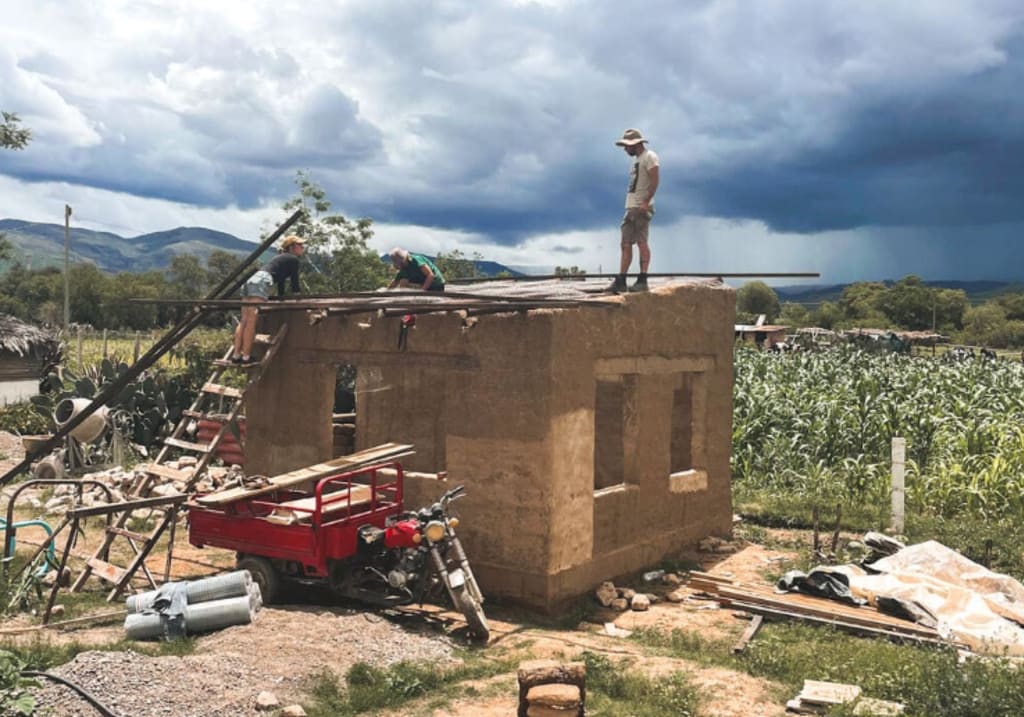Eco houses: how to build for a sustainable future
Discover what eco houses are, follow a step-by-step guide to start building one and find out how you can learn it all through volunteering.
7min

Sustainability and environmental preservation are topics that are increasingly discussed and practiced all around the world. Many people are adopting a more ecofriendly lifestyle, which can include designing and building ecological homes to live in harmony with the environment.
But after all, do you know what an ecological house is? In this article, I will explain the concept, its characteristics, and the main materials used to build one.
What are eco houses?
Eco houses are designed and built with the aim of minimizing environmental impacts. This type of housing preserves all the nature around it, with the idea of integrating the construction with the environment.
Therefore, for the residence to be considered an ecological home, every detail must be thought of from the beginning of its planning.
You might also like these articles:
- Beginners guide to starting a self-sustaining farm
- How to live off the grid with no money: a practical guide

These are some essential characteristics of eco houses:
- Materials: Choosing sustainable building materials is essential in an ecological home. This includes the use of certified wood, recycled materials, non-toxic paints and coatings, aiming to reduce the environmental footprint associated with construction.
- Surroundings: Another important characteristic is to consider the surroundings of the location chosen to build the house. For example, in areas with significant solar incidence, it is crucial to maximize its use. A well-lit house naturally eliminates the need for excess artificial lighting, a concept known as "bioclimatic design".
- Thermal insulation: To ensure a comfortable environment all year round, it is important to consider thermal insulation. This is essential for regulating internal temperature in the hottest and coldest months, eliminating the need of artificial mechanisms to enjoy a pleasant climate.
- Energetic efficiency: An eco-friendly home is designed to be energy efficient, using sunlight as the main source of lighting. In addition to using adequate thermal insulation, high-performance windows and efficient heating and cooling systems.
- Use of renewable energy: This type of residence uses renewable energy sources, such as solar panels, wind turbines or solar heating systems. These technologies help reduce dependence on non-renewable energy sources.
- Water reuse: Ecological homes generally have rainwater harvesting systems, efficient irrigation technologies and water-saving devices, such as low-consumption taps and showers. This contributes to the conservation of this vital resource.
- Waste management: Waste reduction, reuse and recycling are common practices in ecological homes. This includes composting organic waste, properly separating recyclable materials, and minimizing waste during construction.
What is the difference between eco houses and sustainable houses?
An ecological house focuses on reducing environmental impacts even before construction begins. Its project aims to interact with nature, using renewable resources and ecological materials.
While a sustainable house follows urban construction standards, it also features environmentally friendly technologies. Furthermore, it provides a long-term financial return, such as savings on electricity and water bills.

Materials and techniques for building eco houses
There are several techniques that involve bioconstruction, and the choice depends on the raw material available in each location. Many construction techniques use earth as the main raw material, the most common of which are:
Rammed earth
This technique is widely used in countries like Brazil. It is made with earth and other natural materials such as wood, bamboo, or vines to form a basic structure.
It has the advantage of being very economical, as it uses local and easily found materials. Furthermore, it offers good thermal and acoustic insulation, making the home comfortable.
Adobe
Adobes are bricks made from earth along with straw and water, then shaped and dried in the sun. It is one of the most used techniques in bioconstruction, as it prioritizes the use of low environmental impact materials and adopts alternative waste treatment, energy and water consumption systems.
Soil-cement brick
This type of construction consists of a mixture of earth with 10% cement. Its preparation is carried out in a manual or automated machine, which compacts the dough before passing it to the drying process.
Just like all the techniques mentioned above, it also does not require burning.
Cob
Cob is a mixture of earth and dry straw. It is applied to the wall as if it were modeling clay, without requiring additional structures. This technique is very resistant and allows for organic and sculptural forms.
It is a technique similar to adobe, but more used to sculpt walls from the foundation to the ceiling. The advantage is that houses made with this material maintain the interior temperature, functioning as a natural thermal insulator.

How to build an ecological house
The first step to building an ecological house is analyzing the local climate. It is essential to know about the annual temperature, whether the place is dry or humid, and, above all, to be aware of the amount of rain.
This analysis is necessary to identify which materials are suitable for the location. The better this diagnosis, the more comfortable the house will be.
The second step is to research the materials available in the region, such as bamboo, wood, earth, sand, straw, and other materials that can be used for construction.
This step is important to ensure the lowest cost of construction. If there is an abundance of a certain material nearby, there is no need to look for materials elsewhere.
The third step is to look for local labor. People who live in the surrounding area will certainly know about someone specializing in bioconstruction. This interaction with the local community is also interesting to better understand the advantages and disadvantages of the region where the construction will take place.
The next step is to observe the position of the sun and shading to optimize the home's temperature. Shadier areas are ideal for summer, while sunnier areas are advantageous in winter. The ideal is to position the rooms in a direction where they receive morning sunlight.
It’s important to remember that building a house involves numerous risks related to safety, therefore, it is essential to hire a qualified professional, such as an architect or civil engineer.
Learn how to make eco houses by volunteering
Through a work exchange platform called Worldpackers, it is possible to volunteer with bioconstruction and learn different techniques for building an ecological house. This is a great way to contribute to sustainable projects while developing new skills.
The bioconstruction area has grown considerably in recent years, and one of the obstacles is the shortage of specialized labor. With few courses available on the market, doing voluntary work to learn about the topic can open many doors.
You can volunteer in eco projects in more than 140 countries. It's very simple: become a member of Worldpackers and look for vacancies in bioconstruction by using the website’s filters like "Eco program" and "building and maintenance".
Here are some of the positions available around the world:
Travel to Mexico and learn about bioconstruction
Located in Santa Maria Tonameca, Mexico, this host is building a house with bioconstruction techniques and wants volunteers to participate, learn and practice with them by working with the different techniques and principles of bioconstruction.
In exchange for 25 hours of help per week, you will get 2 days off per week, a bed in a shared room, free lunch, bikes at your disposal, holistic therapies, language lessons and a permaculture course, among other perks.
Apply for this volunteering position in Mexico.

Volunteer with bioconstruction in Paraty (Brazil)
In beautiful Paraty (Brazil) there is an opportunity to help build chalets using the wattle and daub technique. If you want to learn how to build houses with your own hands and natural materials, volunteering is a great experience.
You contribute with 25 hours of work per week, spread over 5 days, and in return you receive free accommodation, breakfast, and access to the laundry room. Several travelers who went through this experience mentioned that they learned a lot about bioconstruction and agroforestry.
Check out more information about this opportunity in Paraty.

Learn all about bioconstruction in Paraíba (Brazil)
Another great opportunity for learning how to build eco houses in beautiful Brazil is the vacancy available at Sítio Tupinambá. This host is located at Praia do Conde, one of the most beautiful beaches in the Northeast region of Brazil, just 20 kilometers from João Pessoa, the capital of the state of Paraíba.
This is an ecological community that welcomes volunteers to work with bioconstruction and gardening. In addition to learning how to build an eco house you can also enjoy the beaches in the region, as the site is just a few steps from the sea. You help with 20 hours a week, and the host provides accommodation, breakfast, and bicycles to use at your leisure.
Keep reading about this volunteering opportunity.

Collaborate with a holistic center in Bolivia
In a city called Mizque (Bolivia), which is full of natural beauty, there is a holistic center that welcomes volunteers of all nationalities to support the bioconstruction and gardening of the space.
The host requires 25 hours of work per week and provides free accommodation and all meals (breakfast, lunch, and dinner). Many volunteers who went there said that the experience was wonderful and rewarding, allowing them to learn more about Bolivian culture.
Did you like the idea? See the details of this volunteering position in Bolivia.

Volunteer in a self-sufficient house in Thailand
In Thailand, you can volunteer in a self-sufficient country house and deepen your knowledge on the topic. They ask for 20 hours of work per week, and charge a small fee to cover all your meals and other expenses.
A volunteer who lived this experience said that he learned a lot about sustainability and highlighted that both the accommodation and the meals are incredible. This is an exceptional opportunity to explore Thailand from a unique perspective.
Have you ever thought about spending time in Southeast Asia and, as a bonus, learning how to build an ecological house? Check out the details of this opportunity here.

Keep reading about ecological volunteering:
- Organic gardening: a practical guide to a greener home and lifestyle
- How to support environmental projects around the world
- 6 organic farm volunteer opportunities to apply for today
Not that you know that you can learn how to build an ecological home through volunteering, create a free profile on Worldpackers and pack your bags! This is the best way to learn about bioconstruction in practice and get to know different places and people of all nationalities.
If you liked these tips, follow Worldpackers on social media to get more travel tips and inspiration: we are on Instagram and Tiktok.











